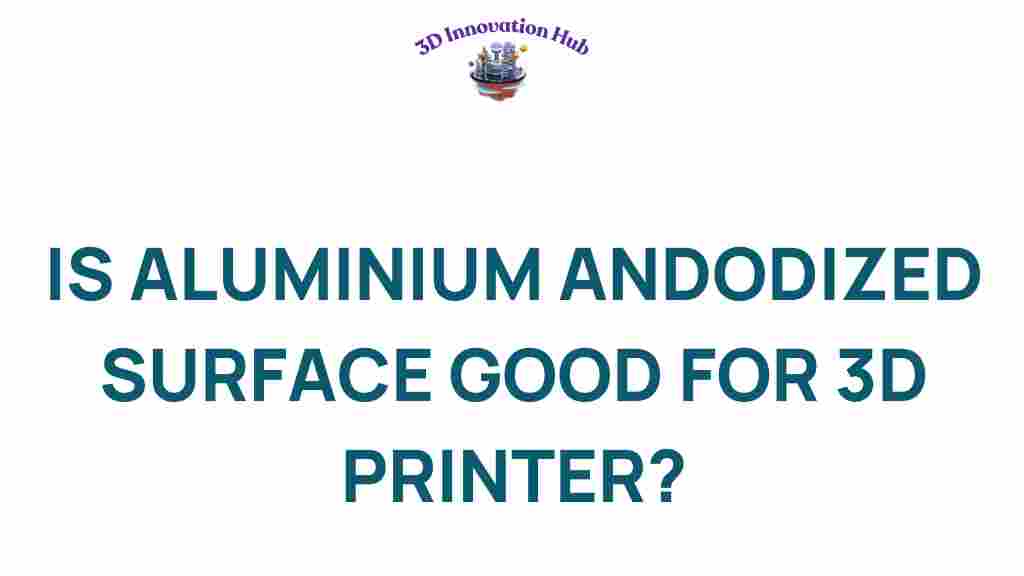Is Anodized Aluminium the Secret to Superior 3D Printing?
In the rapidly evolving world of 3D printing, innovation is key. One material that has gained significant attention is anodized aluminium. Known for its exceptional durability and aesthetic appeal, anodized aluminium is becoming a go-to choice for manufacturers looking to enhance their 3D printing processes. This article explores the benefits of anodized aluminium in 3D printing, its impact on surface finish, and why it may be the secret ingredient to superior manufacturing.
What is Anodized Aluminium?
Anodized aluminium refers to aluminium that has undergone an electrochemical process called anodization. This process enhances the natural oxide layer on the surface of aluminium, resulting in improved corrosion resistance, increased surface hardness, and a more appealing finish.
- Corrosion Resistance: Anodized layers protect the aluminium from oxidation.
- Surface Hardness: The anodized layer is significantly harder than untreated aluminium.
- Aesthetic Appeal: Anodized aluminium can be dyed in various colors, enhancing its visual appeal.
These properties make anodized aluminium an attractive option for various applications, especially in the field of 3D printing.
The Role of Anodized Aluminium in 3D Printing
When it comes to 3D printing, the choice of materials can significantly affect the final product’s quality. Anodized aluminium offers several advantages that can elevate the 3D printing process:
- Enhanced Surface Finish: The anodized layer provides a smoother and more uniform surface, which is crucial for high-quality prints.
- Improved Durability: The hardness of the anodized surface means that parts are less likely to suffer from wear and tear.
- Temperature Resistance: Anodized aluminium can withstand higher temperatures, making it suitable for various printing methods.
These advantages position anodized aluminium as a superior choice for manufacturers seeking to improve their 3D printing capabilities.
Step-by-Step Process of Using Anodized Aluminium in 3D Printing
Integrating anodized aluminium into your 3D printing workflow can be straightforward. Here’s a step-by-step guide:
Step 1: Material Selection
Choose the right grade of anodized aluminium for your project. Common grades include:
- 6061-T6: Offers good mechanical properties and weldability.
- 7075-T6: Known for its high strength-to-weight ratio.
Step 2: Design Considerations
When designing your 3D model, consider the properties of anodized aluminium:
- Design for manufacturability to ensure the final product meets strength and aesthetic requirements.
- Account for the anodized layer in your tolerances, as it can add thickness to the final piece.
Step 3: Printing Process
Use a suitable 3D printing method. Anodized aluminium can be used in:
- Fused Deposition Modeling (FDM): Ideal for creating prototypes and functional parts.
- Selective Laser Melting (SLM): Best for producing high-density components.
Step 4: Post-Processing
After printing, ensure proper post-processing:
- Cleaning: Remove any excess material or support structures.
- Finishing: Consider additional processes like polishing or an extra anodizing layer for enhanced aesthetics.
Troubleshooting Common Issues with Anodized Aluminium in 3D Printing
While anodized aluminium has many benefits, there can be challenges in the 3D printing process. Here are some common issues and troubleshooting tips:
Issue 1: Poor Adhesion
If your prints are not adhering well to the build plate, consider:
- Adjusting the bed temperature.
- Using a different adhesion method, such as a glue stick or specialized tape.
Issue 2: Surface Imperfections
Surface imperfections can detract from the final product. To mitigate this:
- Ensure your printer is calibrated correctly.
- Check the quality of your anodized aluminium to ensure it meets your specifications.
Issue 3: Inconsistent Layering
Inconsistent layering can lead to weak structures. To resolve this:
- Examine your extrusion settings.
- Adjust your print speed and temperature settings.
Conclusion: Anodized Aluminium as a Game-Changer in 3D Printing
As 3D printing technology continues to advance, the materials we use play a crucial role in determining the quality and durability of the final products. Anodized aluminium stands out as a superior choice, thanks to its excellent surface finish, enhanced durability, and aesthetic versatility.
Whether you’re a hobbyist or a professional manufacturer, incorporating anodized aluminium into your printing process could be the key to unlocking new levels of innovation and quality in your projects. For more insights on manufacturing techniques and material innovations, check out this resource.
In summary, anodized aluminium is not just a material; it’s a solution that combines functionality with aesthetics, making it a secret weapon in the world of 3D printing.
For further reading on 3D printing technologies, visit this page.
This article is in the category and created by 3D Innovation Hub Team
